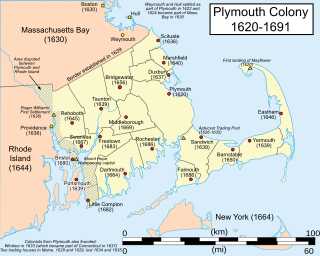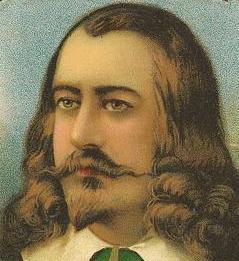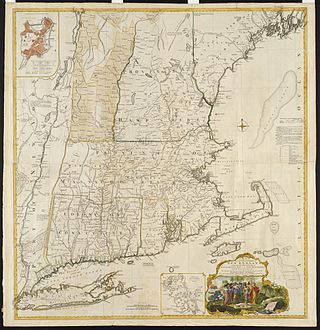
The Pequot are a Native American people of Connecticut. The modern Pequot are members of the federally recognized Mashantucket Pequot Tribe, four other state-recognized groups in Connecticut including the Eastern Pequot Tribal Nation, or the Brothertown Indians of Wisconsin. They historically spoke Pequot, a dialect of the Mohegan-Pequot language, which became extinct by the early 20th century. Some tribal members are undertaking revival efforts.

Myles Standish was an English military officer and colonist. He was hired as military adviser for Plymouth Colony in present-day Massachusetts, United States by the Pilgrims. Standish accompanied the Pilgrims on the ship Mayflower and played a leading role in the administration and defense of Plymouth Colony from its foundation in 1620. On February 17, 1621, the Plymouth Colony militia elected him as its first commander and continued to re-elect him to that position for the remainder of his life. Standish served at various times as an agent of Plymouth Colony on a return trip to England, as assistant governor of the colony, and as its treasurer.

Plymouth Colony was the first permanent English colony in New England from 1620 and the third permanent English colony in America, after Newfoundland and the Jamestown Colony. It was settled by the passengers on the Mayflower at a location that had previously been surveyed and named by Captain John Smith. The settlement served as the capital of the colony and developed as the town of Plymouth, Massachusetts. At its height, Plymouth Colony occupied most of what is now the southeastern portion of Massachusetts. Many of the people and events surrounding Plymouth Colony have become part of American folklore, including the American tradition of Thanksgiving and the monument of Plymouth Rock.

William Bradford was an English Puritan Separatist originally from the West Riding of Yorkshire in Northern England. He moved to Leiden in Holland in order to escape persecution from King James I of England, and then emigrated to the Plymouth Colony on the Mayflower in 1620. He was a signatory to the Mayflower Compact and went on to serve as Governor of the Plymouth Colony intermittently for about 30 years between 1621 and 1657. He served as a commissioner of the United Colonies of New England on multiple occasions and served twice as president. His journal Of Plymouth Plantation covered the years from 1620 to 1646 in Plymouth.

Plymouth is a town and county seat of Plymouth County, Massachusetts, United States. Located in Greater Boston, the town holds a place of great prominence in American history, folklore, and culture, and is known as "America's Hometown". Plymouth was the site of the colony founded in 1620 by the Mayflower Pilgrims, where New England was first established. It is the oldest municipality in New England and one of the oldest in the United States. The town has served as the location of several prominent events, one of the more notable being the First Thanksgiving feast. Plymouth served as the capital of Plymouth Colony from its founding in 1620 until the colony's merger with the Massachusetts Bay Colony in 1691. The English explorer John Smith named the area Plymouth and the region 'New England' during his voyage of 1614. It was a later coincidence that, after an aborted attempt to make the 1620 trans-Atlantic crossing from Southampton, the Mayflower finally set sail for America from Plymouth, England.

Tisquantum, more commonly known as Squanto, was a member of the Wampanoag Patuxet tribe best known for being an early liaison between the Native American population in Southern New England and the Mayflower Pilgrims who made their settlement at the site of Tisquantum's former summer village, now Plymouth, Massachusetts. The Patuxet tribe had lived on the western coast of Cape Cod Bay, but an epidemic infection wiped them out, likely brought by previous European explorers.

Samoset was an Abenaki sagamore and the first American Indian to make contact with the Pilgrims of Plymouth Colony in New England. He startled the colonists on March 16, 1621 by walking into Plymouth Colony and greeting them in English, saying "Welcome, Englishmen."

The Wampanoag, also rendered Wôpanâak, are a Native American people of the Northeastern Woodlands currently based in southeastern Massachusetts and formerly parts of eastern Rhode Island. Their historical territory includes the islands of Martha's Vineyard and Nantucket.

John Carver was one of the Pilgrims who made the Mayflower voyage in 1620 which resulted in the creation of Plymouth Colony in America. He is credited with writing the Mayflower Compact and was its first signer, and was also the first governor of Plymouth Colony.

Massasoit Sachem or Ousamequin was the sachem or leader of the Wampanoag confederacy. Massasoit means Great Sachem. Massasoit was not his name but a title. English colonists mistook Massasoit as his name and it stuck.

The Pokanoket was the village governed by Massasoit. The term broadened to refer to all peoples and lands governed by Massasoit and his successors, which were part of the Wampanoag people in what is now Rhode Island and Massachusetts.

Plimoth Patuxet is a complex of living history museums in Plymouth, Massachusetts founded in 1947, formerly Plimoth Plantation. It replicates the original settlement of the Plymouth Colony established in the 17th century by the English colonists who became known as the Pilgrims. They were among the first people who emigrated to America to seek religious separation from the Church of England. It is a not-for-profit museum supported by administrations, contributions, grants, and volunteers. The recreations are based upon a wide variety of first-hand and second-hand records, accounts, articles, and period paintings and artifacts, and the museum conducts ongoing research and scholarship, including historical archaeological excavation and curation locally and abroad.

The Massachusett were a Native American tribe from the region in and around present-day Greater Boston in the Commonwealth of Massachusetts. The name comes from the Massachusett language term for "At the Great Hill," referring to the Blue Hills overlooking Boston Harbor from the south.
Corbitant was a Wampanoag sachem under Massasoit. Corbitant was the sachem of the Pocasset tribe in present-day North Tiverton, Rhode Island, c. 1618–1630. He lived in Mattapuyst or Mattapoiset, located in the southern part of today's Swansea, Massachusetts.
Thomas Dermer was a 17th-century navigator and explorer. Thomas Dermer explored the eastern coastline of America from 1614 to 1620. He was associated with Captain John Smith, The Newfoundland Company, Sir Ferdinando Gorges, Jamestown, The Plymouth Company, and The Merchant Adventurers. Dermer, working side by side with Squanto, is credited with starting to normalize the relations between the Native Americans and Europeans. He was known to the Pilgrims from copies of his letters, that they had obtained. The Pilgrim colony directly benefited from the diplomatic ground work of Dermer and Squanto.

George Weymouth (Waymouth) was an English explorer and colonist of the area now occupied by the state of Maine. George Weymouth was a native of Cockington, Devon, who spent his youth studying shipbuilding and mathematics. His travels are among the early recorded contacts between Wabanaki nations and people of Northern Europe.
Hobbamock was a Pokanoket pniese who came to live with the Plymouth Colony settlers during the first year of their settlement in North America in 1620. His name was variously spelled in 17th century documents and today is generally simplified as Hobomok. He is known for his rivalry with Squanto, who lived with the settlers before him. He was greatly trusted by Myles Standish, the colony's military commander, and he joined with Standish in a military raid against the Massachuset. Hobomock was also greatly devoted to Massasoit, the sachem of the Pokanoket, who befriended the English settlers. Hobomok is often claimed to have been converted to Christianity, but what that meant to him is unclear.

The New England Colonies of British America included Connecticut Colony, the Colony of Rhode Island and Providence Plantations, Massachusetts Bay Colony, Plymouth Colony, and the Province of New Hampshire, as well as a few smaller short-lived colonies. The New England colonies were part of the Thirteen Colonies and eventually became five of the six states in New England, with Plymouth Colony absorbed into Massachusetts and Maine separating from it.
Paula Peters is a journalist, educator and activist. A member of the Wampanoag tribe, she has spent most of her life in her tribal homeland of Mashpee, Massachusetts. She hails from a prominent Mashpee Wampanoag family, including Tribal Chairman Russell "Fast Turtle" Peters, and was active in the tribe's long and contested push for federal recognition. In a 2006 interview with NPR, Peters recalled a time when "nobody in Washington cared much about which tribes were recognized." Like her father before her, Peters served on the Mashpee Wampanoag Tribal Council. In 2005, she ran against Glenn Marshall for Council Chairperson.
Aspinet was a sagamore of the Nauset people.
















